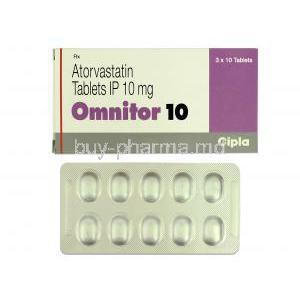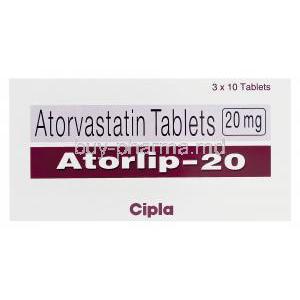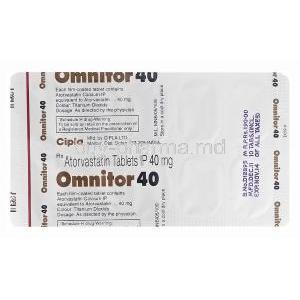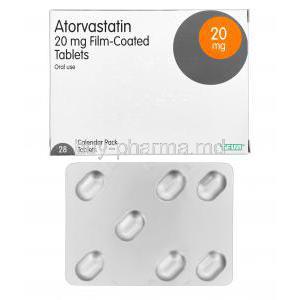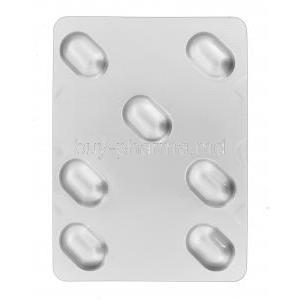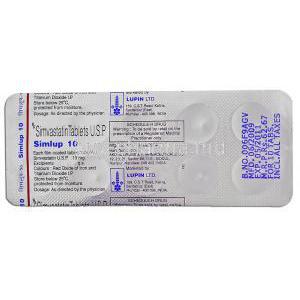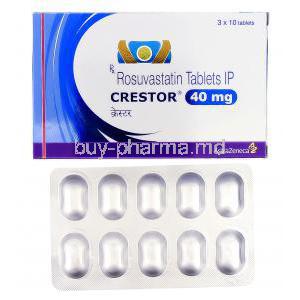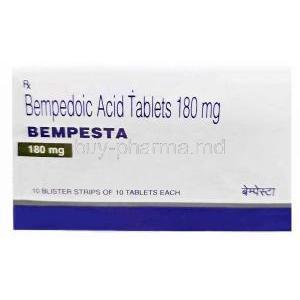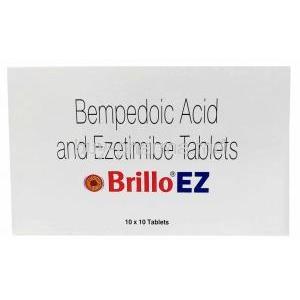Atorvastatin
- I. Introduction to Atorvastatin
- II. Composition of Atorvastatin
- III. How Atorvastatin Works: Unveiling the Mechanism of Action
- IV. Uses of Atorvastatin: Medical Indications
- V. Off-label Uses of Atorvastatin
- VI. Dosage and Administration of Atorvastatin
- VII. Special Considerations in Atorvastatin Administration
- VIII. Side Effects of Atorvastatin: A Comprehensive Review
- IX. Drug Interactions with Atorvastatin
- X. Contraindications and Warnings Associated with Atorvastatin Use
- XI. Overdosage of Atorvastatin: Symptoms and Management
- XII. Storage and Handling Precautions for Atorvastatin
- XIII. Conclusion
I. Introduction to Atorvastatin
A. Brief overview of Atorvastatin
As a member of the statin family, Atorvastatin has gained widespread popularity due to its efficacy in lowering cholesterol levels. Physicians widely utilize it for patients suffering from various cardiovascular illnesses like myocardial infarction and stroke. This medication stimulates curbing the body's natural production of artery-clogging cholesterol by blocking the action of the crucial liver enzyme HMG CoA reductase responsible for synthesizing it.
B. Role and significance in the medical field
Atorvastatin contributes significantly to cardiovascular therapeutics in the wide-ranging pharmacological interventions intended for various purposes. Its vital role becomes apparent regarding atherosclerosis - an ailment that involves the accumulation of plaque containing high LDL levels within the arteries - as it acts as a productive measure against this condition. Reducing LDL cholesterol or "bad" cholesterol levels while raising HDL or "good" levels and minimizing triglycerides within our bloodstream, Atorvostain helps prevent heart attacks and avert stroke hazards effectively. Additionally, at par with providing cardio-protective benefits, new studies suggest promising prospects for using atorvastatin treatment in multiple therapy scenarios, such as neurodegenerative conditions or treating specific cancers in addition to aiding Covid 19 patients.
II. Composition of Atorvastatin
A. Key active and inactive ingredients
Atorvastatin's primary functionality comes from Atorvastatin Calcium as an active compound - mainly as it inhibits HMG CoA reductase enzymes within the body. This medication is not made up of solely this one ingredient; inactive ones work significantly with this chemical to stabilize it and allow easier absorption by users' bodies - some examples include microcrystalline cellulose or anhydrous dibasic calcium phosphate. Lactose monohydrate and magnesium stearate also contribute significantly towards enhancing its beneficial effects for individuals using this drug - however, exact formulations differ according to which manufacturer produces them.
B. Variants and strengths of Atorvastatin
When it comes to catering to the diverse therapeutic needs of individuals against reducing high cholesterol levels, versatile doses are available for Atorvastatin 10 mg.,20 mg.,40 mg., and even at strong potency like 80 mg. A wise selection of the appropriate dosage depends on several factors, including illness chronicity. It lowers cholesterol levels and patients' responses to previous treatments. In addition to its standalone benefits, Atorvastatin is an essential component of combination drugs where it is paired with other active agents like Amlodipine and others. These combinations help expand the therapeutic utility range that Atorvastatin can bring about.
III. How Atorvastatin Works: Unveiling the Mechanism of Action

A. Impact on cholesterol levels
Atorvastatin blocks the HMG CoA reductase enzyme, which is integral to cholesterol biosynthesis within the liver. Through inhibition of this enzymatic activity, Atorvastatin lessens endogenous synthesis leading to decreased levels of LDL cholesterol and triglycerides—both strongly correlated with heart health outcomes. Atorvastatin modulates the upregulation of LDL receptors on liver cells for increased clearance rates responsible for decreasing circulating levels further. This coordinated intervention precisely lowers total serum cholesterol concentrations, thus fostering an environment hostile to the formation and progression of harmful arterial plaque.
B. Effect on heart health
Atorvastatins' positive impact on cardiac well-being is considerable. Specifically, it acts on two central agents driving atherosclerotic plaque formation: LDL cholesterol and triglycerides. By decreasing their concentration alongside boosting HDL cholesterol (good cholesterol), this medication stimulates 'reverse cholesterol transport, 'consequently ameliorating unhealthy plaque accumulation within arteries, as a result of these mechanisms working together successfully. Critical cardiovascular events - like myocardial infarction (heart attack) or stroke - have significantly reduced chances of occurring.
IV. Uses of Atorvastatin: Medical Indications
A. Primary uses: Lowering cholesterol and reducing heart disease risks
Atorvastatin's primary uses include:
- Hypercholesterolemia: To reduce elevated total-C, LDL-C, apo B, and TG levels and to increase HDL-C in adults with primary hypercholesterolemia or mixed dyslipidemia. Reference: National Center for Biotechnology Information.
- Prophylaxis of cardiovascular events: To prevent cardiovascular complications in patients with multiple risk factors for heart disease or a history of heart disease. Reference: American Heart Association Journals.
B. Secondary uses: Stroke prevention and beyond
Although typically prescribed for specific health concerns, Atorvastatin may potentially address other medical issues. For instance, it has been shown to lower the occurrence of subsequent strokes among individuals with previous strokes or transient ischemic attacks (TIAs). Reference: National Center for Biotechnology Information.
Furthermore, emerging research points to the possible antioxidant and anti-inflammatory effects of Atorvastatin which offer therapeutic possibilities in treating ailments like rheumatoid arthritis or chronic obstructive pulmonary disease (COPD). References: National Center for Biotechnology Information, National Center for Biotechnology Information.
V. Off-label Uses of Atorvastatin
A. Off-label benefits in non-cardiovascular conditions
Atorvastatin is a well-known drug for regulating lipid levels and reducing the risk of cardiovascular disease. However, recent studies have explored the medication's off-label applications in treating various noncardiovascular ailments, revealing its versatility as a pharmacological agent. One notable area where Atorvastatin has shown therapeutic promise is in treating certain rheumatological conditions like rheumatoid arthritis and systemic lupus erythematosus. Reference: National Center for Biotechnology Information.
Researchers believe suppressing inflammatory responses with this drug may help alleviate or prevent these diseases' symptoms. Furthermore, there are indications that Atorvastatin may play a crucial role in neurodegenerative conditions such as Alzheimer's disease and multiple sclerosis. Reference: ScienceDirect.
However, further studies are necessary to precisely understand how the medication works here. It's speculated that its effects arise from improved cerebral blood flow or reduced neuroinflammation - factors suggesting promising potential for neuroprotective therapies. Reference: PubMed.
B. Research findings and ongoing studies on off-label uses
Atorvastatin has created a buzz with its off-label therapeutic benefits and untapped possibilities following recent research into how it can benefit individuals across formerly uncharted diagnostics territories. The "Journal of Neurological Sciences" states that administering Atorvastatin may reduce neurodegeneration among multiple sclerosis patients. Reference: ScienceDirect.
This revelation has fueled an even greater desire to carry out additional research on statin drugs' use in crucial areas like neuroprotection. Its efficiency in assisting those with rheumatological conditions generates optimism thanks to clinical trials such as the one published in "The Lancet," which shows that disease activity scores improve significantly with use among users diagnosed with rheumatoid arthritis. Reference: The Lancet.
At the same time, these studies provide promising results. It remains critical to carefully vet any off-label use as regulatory bodies are still conducting exhaustive studies to authenticate their safety and effectiveness for daily clinical practices. Reference: FDA.
VI. Dosage and Administration of Atorvastatin
A. Standard dosage guidelines
Care providers establish atorvastatin dosages after evaluating patient responses and treatment goals. Those with high cholesterol usually start a steady regimen of ten or twenty milligrams once daily, depending on necessity. Over time providers adjust doses between intervals lasting two or four weeks until reaching a practical goal for lowering LDL-C levels while avoiding exceeding eighty milligrams per day. At any given point throughout their treatment regimen, patients can consume Atorvastatin with or without food while keeping their scheduled dosage daily.
B. Special dosage considerations based on individual factors
Although there are standard instructions for administering Atorvastatin, specific criteria like age or renal functionality alongside co-administered medication must be considered before finalizing its dosage recommendations for any patient. Notably for those with poor kidney health, as their liver processes, this drug differently, requiring potential doses reassessment if needed. Furthermore, some drugs taken concurrently can increase muscle complications that may call for lowering the Atorvastatin dose.
VII. Special Considerations in Atorvastatin Administration
A. Administration to the elderly: Precautions and Adjustments
When working with elderly patients undergoing treatment with Atorvastatin, individual medical providers should remain extra wary of any shifts in drug response that could arise from age-related changes affecting how this statin is absorbed or metabolized within their bodies. This can ultimately manifest through varying outcomes along different points of care within a healthcare provider's purview, precisely where young vs. senior patient populations are being compared, as there isn't an established point to modify treatment dosage based solely on advanced age. It is highly suggested that healthcare providers exercise additional caution when handling Atorvastatin dosing regimens with older patients who may also be experiencing decreased organ functionality, as well as existing health conditions or concomitant medication therapy.
B. Administration to pregnant women and nursing mothers: Risks and Recommendations
Given the FDA classification of drugs for pregnant women and an analysis of evidence for Atorvastatin usage during pregnancy has ranked it under Category X, indicating that its potential dangers are more prominent than benefits. Consequently, expectant mothers or those planning to conceive must not ingest this medication at all costs. Besides that, nursing mothers consuming Atorvastatin could expose their babies to severe side effects caused by statins; hence they must cease breastfeeding their little ones while on medication.
C. Administration to children: Safety and Efficacy
Children with heterozygous familial hypercholesterolemia can benefit from Atorvastatin as it is a secure and effective treatment option for patients aged ten years and above. Nevertheless, prescribers must thoughtfully examine potential risks versus rewards before giving Atorvastatin to minors.
VIII. Side Effects of Atorvastatin: A Comprehensive Review
A. Common side effects and their management
Atorvastatin may cause certain unwanted effects, such as headaches and digestive issues (dyspepsia), additionally, patients may experience feelings of nausea or inflammation within the nasal passage region leading to nasopharyngitis. While these symptoms are generally considered mild and temporary, a doctor should be consulted if they remain persistent or worsen in intensity during continued use of Atorvastatin.
B. Rare but serious side effects: What to watch out for
While infrequent, one must exercise caution since Atorvastatin may cause secondary complications like rhabdomyolysis- which induces muscle breakdown culminating in kidney failure. It typically presents itself via symptoms such as muscle tenderness, weakness, and feverishness. Additionally, Atorvastatin can bring about liver abnormalities accordingly; it's necessary to conduct routine serum enzyme tests on individual patients. Liver problems exhibit signs such as uncharacteristic exhaustion, reduced appetite levels, discomfort within the upper-right part of one's abdomen, and jaundiced skin/whites of eye coloration/pigmentation changes within urine tone/coloration.
IX. Drug Interactions with Atorvastatin
A. Potential interactions with commonly used medications
As with any medication, Atorvastatin has potential drug interactions that must be noted carefully to minimize any negative consequences on health outcomes. Anticipated drug interactions may alter its effectiveness and heighten possibilities for severe side effects like myopathy or muscle damage. Significant interactions include certain antifungal drugs such as itraconazole which increases concentration levels of atorvastatin, leading to heightened side effect risks while taking this medication. Furthermore, macrolide antibiotics like erythromycin or clarithromycin can also affect atorvastatin levels in the blood, requiring caution. Finally, protease inhibitors used to treat HIV significantly impact Atorvastatin metabolism leading to muscle damage concerns.
B. Interactions with food and alcohol: Facts and myths
It is commonly known that drinking alcohol and taking certain medications simultaneously may cause harmful interactions. In particular, excessive drinking while on Atorvastatin can heighten liver damage concerns and pose other threats to one's health. Hence, responsible and moderate alcohol use is highly advisable to ensure safe medication use and minimal side effects.
X. Contraindications and Warnings Associated with Atorvastatin Use
A. When Atorvastatin should not be used: Absolute Contraindications
Individuals considering Atorvastatin as part of their treatment options are advised against usage under certain circumstances. In particular, those demonstrating a known hypersensitivity toward any component in the medication are discouraged from taking it due to possible health consequences. Furthermore, individuals diagnosed with active liver disease or experiencing unexplained persistent increases in hepatic transaminase levels should also avoid Atorvastatin altogether. Finally, given the potential risks to fetal development or infant safety. Pregnant and lactating women must avoid this medication.
B. Situations requiring cautious use of Atorvastatin
Atorvastatin must be approached carefully in certain conditions to maintain effectiveness and minimize risks. At the same time, renal function does not significantly affect its efficacy or safety due to hepatic processing. Monitoring patients with impaired renal function is strongly recommended as an extra precautionary measure. Moreover, individuals who have previously misused alcohol must remember their heightened risk for developing liver-related side effects when taking Atorvastatin and speak openly with healthcare providers to receive proper guidance and monitoring.
XI. Overdosage of Atorvastatin: Symptoms and Management
A. Identifying signs of Atorvastatin overdose
Not much data exists on overdosing with Atorvastatin. Typical side effects like gut problems, headaches, and muscle pain can worsen in such cases. Severe incidents could cause myopathy or harm to the kidneys.
B. Immediate steps and medical interventions for Atorvastatin overdose
Early medical intervention should be a top priority in drug overdose incidents to mitigate potentially dire outcomes. Supporting clinical approaches should be adopted swiftly to aid vital organ function maintenance purposes under such circumstances. While Atorvastatin is poorly eliminated via hemodialysis during extreme instances of oversupply ingestion and eventual poisoning or toxin exposure events that might arise, prescription medication intake should still be considered in light of co-occurring complications that warrant further attention and management by medical care teams. Poison control centers offer immediate assistance lines throughout all regions under their watchful eye.
XII. Storage and Handling Precautions for Atorvastatin
A. Ideal storage conditions for Atorvastatin
Atorvastatin belongs to a group of drugs requiring careful storage conditions to maintain effectiveness and safety. Keeping this medication at room temperature, around 20-25°C (68-77°F), is essential since any deviation from this range could undermine its quality. You should also guard your Atorvastatin supply against moisture and excessive heat since they can harm its integrity. To achieve this, you must avoid storing the drug in damp places like bathrooms or in proximity to kitchen sinks. Furthermore, preserving your Atorvastatin in its original container shields it from light exposure that would otherwise cause degradation. Remember always to fasten the cap securely after use lest air sneaks in and compromises your medication.
B. Safeguarding Atorvastatin from children and pets
To avoid any risk of unintended ingestion. Make sure to store Atorvastatin securely from children and animals. The medication resembles candy or food because of its size and shape; thus, kids or pets might mistakenly eat it, leading to dangerous outcomes. Suppose kids or pets get their hands on Atorvastatin by chance somehow. Take prompt action by reaching out for medical aid straight away without any delay. Also, keep important emergency contacts accessible for quick access during critical moments.
XIII. Conclusion

A. Recap of Atorvastatin's role, benefits, and risks
To manage high cholesterol levels effectively and decrease the risk of cardiovascular disease. Atorvastatin is an essential medication that plays a crucial role by inhibiting an enzyme that produces cholesterol in the liver. It promotes heart health benefits significantly. It's vital to keep possible side effects and interactions in mind despite its advantages when using this drug. Side effects such as headaches, dyspepsia, or nasopharyngitis are prevalent but not severe; however, rare but serious adverse events like liver abnormalities or rhabdomyolysis must be considered.
B. Final words on safe and effective use of Atorvastatin
Patients seeking optimal results from taking Atorvastatin must adhere to prescribed dosages carefully while swiftly notifying their healthcare provider of any unfavorable reactions experienced. Routine monitoring of cholesterol levels through regular check-ins is paramount while keeping tabs on liver function by undergoing check-ups also holds immense significance. Compliant adherence and respect for these fundamental requirements will pave the way for successfully using Atorvastatins' therapeutic potential while minimizing avoidable risks or complications.












































